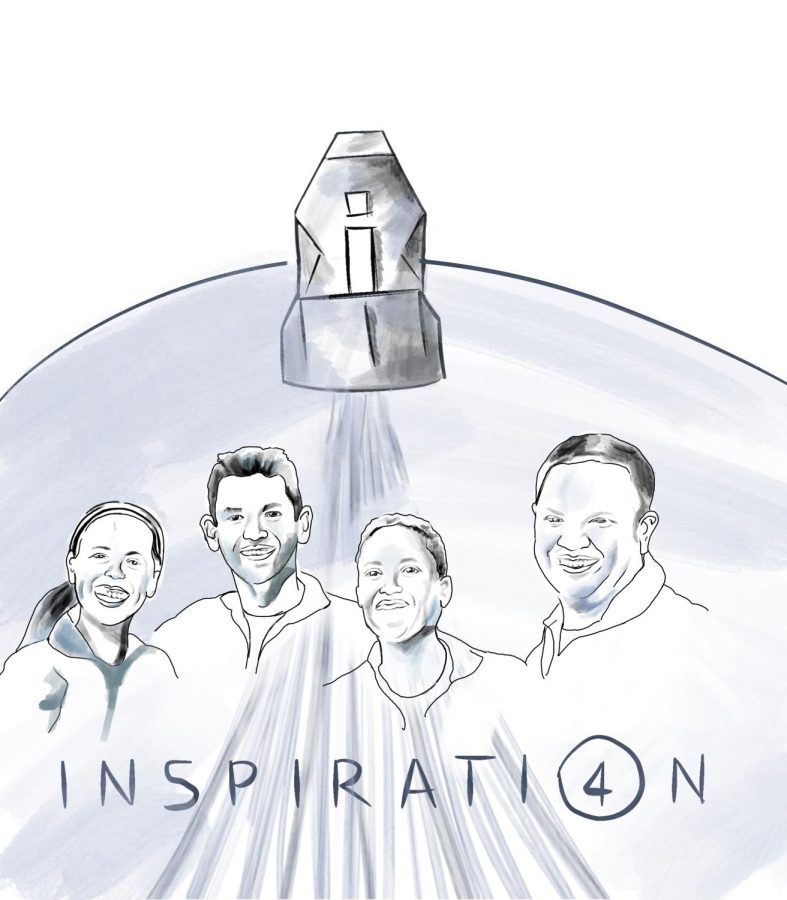A new generation of space travel
How Inspiration4 opens the door for commercial spaceflight
Nicole Tian and Sabrina Zhu
Inspiration4, a space mission managed by SpaceX that carried the first civilian crew into orbit, successfully launched from Kennedy Space Center on Sept. 15 and landed three days later off the coast of the space center. Jared Isaacman, the CEO of Shift4 Payments, captained the mission and bought the flight to support and raise funds for the St. Jude Children’s Research Hospital.
Tendrils of fading mist float off the frigid engines of Inspiration4 five minutes before takeoff, a result of the supercooled liquid oxygen chilling the engines prelaunch. In SpaceX’s YouTube livestream, the sterile white strongback holding the rocket up begins to retreat slowly as the audience erupts in applause, anticipating the liftoff. “T-15 seconds. 10, 9, 8, 7, 6, 5, 4, 3, 2, 1.” A blazing orange glow pierces the air as a cloud of illuminated smoke plumes from under the rocket, rising into the depths of the open night sky.
Inspiration4, a space mission managed by SpaceX that carried the first civilian crew into orbit, successfully launched from Kennedy Space Center on Sept. 15 and landed three days later off the coast of the space center. Jared Isaacman, the CEO of Shift4 Payments, captained the mission and bought the flight to support and raise funds for the St. Jude Children’s Research Hospital.
He hoped to raise $200 million from the flight, and has since raised over $230 million for St. Jude, $125 million of which came from Isaacman himself. St. Jude will continue the fundraiser through Feb. 2022. The crew aims to “represent a new era for human spaceflight and exploration” through their travel into orbit.
Inspiration4’s crew consists of four members, with Isaacman as the leader, and the other three representing a tenet of their mission: hope, generosity and prosperity. Hayley Arceneaux, the youngest American in space, embodies hope due to her childhood fight against osteosarcoma, a form of bone cancer. She returned to St. Jude as a physician assistant to help others struggling with cancer. John Sembroski characterizes generosity because of his decades of work in the aerospace industry and his time serving in the air force. He was chosen through a raffle of St. Jude donors. Sian Proctor, a geoscientist, professor and pilot, personifies prosperity, and was a former astronaut finalist in 2009.
As a private endeavor, the crew of Inspiration4 comes from a variety of different backgrounds. Hayley Arceneaux is the first person with a prosthetic to go into space, and Sian Proctor is the first Black woman to pilot a space shuttle. Cynthia Wang (10), a member of the Aerospace Club, notes that because space travel is becoming public, a more diverse range of people will be going to space.
“Having a civilian sponsored space mission offers the idea that everyone may have an opportunity to travel to space if that’s what they want to do, rather than the government,” Cynthia said. “ I think it just opens a lot of doors for the future of space travel. I feel like that resonated with a lot of people, the diversity.”
Opening space travel to civilians also creates more opportunities for scientists and engineers in the private sector to become involved in the progression of aerospace technology and research. For example, Relativity Space is working on creating the first 3D-printed rocket which plans to launch in 2024.
“I think that the commercialization of space flight will help people advance science a lot, because, as we saw in the Inspiration4 mission, they went up and they did a few orbits, but they also did experiments onboard there,” said Grant Sims (11), head of design for the Aerospace Club. “The more people are going up, the more opportunities there are for science.”
Although paceflight in today’s age is still limited to the minority of the extremely wealthy, Anthony Silk, upper school math teacher and adviser of the Aerospace Club, believes that in the future, space travel for common people will become more affordable and accessible.
“We’ve gotten to a point now that commercial space travel is possible,” Silk said. “It’s no different than a hundred years ago when the Wright brothers started flying and then people could pay to fly with them. In the beginning, only the wealthy could pay to fly, and then eventually it became common enough that anyone could do it. I think we’re just going through the same cycle.”
As of now, space travel is still in its infancy, but future space missions and modern media continue to document upcoming astronauts and scientists. Netflix has released a special on the Inspiration4 flight, and Discovery plans to release a game show offering a spot on a future mission from Axiom, a different private space company. In a world that increasingly draws on the limitless possibilities of outer space, astronautic technology will continue to advance exponentially.
“I think that as more people are going into space, as there’s more developments in that area, [there’s] going to be more technology emerging, better spaceships, better safety systems,” Grant said. “It’s a really exciting time to live in.”

Margaret Cartee 12) is a co-managing editor for Harker Aquila, and this is her fourth year on staff. This year, Margaret wants to do more illustrations...


















![“[Building nerf blasters] became this outlet of creativity for me that hasn't been matched by anything else. The process [of] making a build complete to your desire is such a painstakingly difficult process, but I've had to learn from [the skills needed from] soldering to proper painting. There's so many different options for everything, if you think about it, it exists. The best part is [that] if it doesn't exist, you can build it yourself," Ishaan Parate said.](https://harkeraquila.com/wp-content/uploads/2022/08/DSC_8149-900x604.jpg)




![“When I came into high school, I was ready to be a follower. But DECA was a game changer for me. It helped me overcome my fear of public speaking, and it's played such a major role in who I've become today. To be able to successfully lead a chapter of 150 students, an officer team and be one of the upperclassmen I once really admired is something I'm [really] proud of,” Anvitha Tummala ('21) said.](https://harkeraquila.com/wp-content/uploads/2021/07/Screen-Shot-2021-07-25-at-9.50.05-AM-900x594.png)







![“I think getting up in the morning and having a sense of purpose [is exciting]. I think without a certain amount of drive, life is kind of obsolete and mundane, and I think having that every single day is what makes each day unique and kind of makes life exciting,” Neymika Jain (12) said.](https://harkeraquila.com/wp-content/uploads/2017/06/Screen-Shot-2017-06-03-at-4.54.16-PM.png)








![“My slogan is ‘slow feet, don’t eat, and I’m hungry.’ You need to run fast to get where you are–you aren't going to get those championships if you aren't fast,” Angel Cervantes (12) said. “I want to do well in school on my tests and in track and win championships for my team. I live by that, [and] I can do that anywhere: in the classroom or on the field.”](https://harkeraquila.com/wp-content/uploads/2018/06/DSC5146-900x601.jpg)
![“[Volleyball has] taught me how to fall correctly, and another thing it taught is that you don’t have to be the best at something to be good at it. If you just hit the ball in a smart way, then it still scores points and you’re good at it. You could be a background player and still make a much bigger impact on the team than you would think,” Anya Gert (’20) said.](https://harkeraquila.com/wp-content/uploads/2020/06/AnnaGert_JinTuan_HoHPhotoEdited-600x900.jpeg)

![“I'm not nearly there yet, but [my confidence has] definitely been getting better since I was pretty shy and timid coming into Harker my freshman year. I know that there's a lot of people that are really confident in what they do, and I really admire them. Everyone's so driven and that has really pushed me to kind of try to find my own place in high school and be more confident,” Alyssa Huang (’20) said.](https://harkeraquila.com/wp-content/uploads/2020/06/AlyssaHuang_EmilyChen_HoHPhoto-900x749.jpeg)




